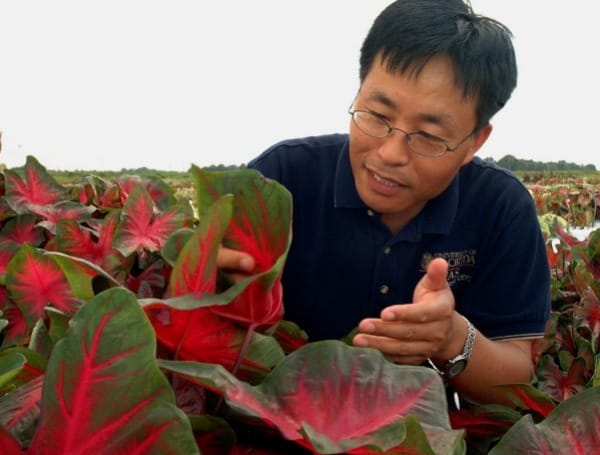BALM, Fla. – If you’re impatient for impatiens, a University of Florida scientist has good news for you: Some varieties of the popular flower resist the deadly downy mildew disease better than others.
Many people love to plant impatiens – also known as the “Touch Me Not” — in their gardens, yards and patios because of their bright, colorful flowers and tolerance to shade, said Zhanao Deng. The UF/IFAS ornamental plant breeder leads cutting-edge research to find out how he can bolster the impatiens industry by eliminating the downy mildew pathogen.
“Downy mildew is a highly destructive disease in a wide range of crops worldwide, not just impatiens,” said Deng, a UF/IFAS environmental horticulture professor at the Gulf Coast Research and Education Center. The disease can cause extensive damage to lettuce, basil, melon, squash, and grapes, among others.
Several outbreaks of impatiens downy mildew have been reported in Europe, Australia, and North America. The disease has translated to decreases in wholesale values of impatiens in the United States from about $150 million in 2005 to $65 million in 2015.
But better days are ahead for nurseries, garden centers and flower-loving consumers.
Through extensive testing, Deng and his research team found two New Guinea impatiens varieties that can resist downy mildew throughout the flower’s entire life, even when their tiny plants first emerge from seeds. To allow rapid testing of impatiens varieties and breeding materials, the researchers developed a method to inoculate impatiens, and they found which varieties are more resistant or more susceptible to the pathogen when impatiens plants are at their early growth stage.

They tested 16 garden impatiens and 16 New Guinea impatiens varieties in Florida. Their findings, as just published in the journal Nature Horticulture Research, showed all New Guinea impatiens varieties resisted the pathogen after their first true leaves have emerged.
“However, many of these New Guinea impatiens varieties have an Achilles’ heel: They are susceptible to downy mildew at the stage when the young plants first emerged from seeds,” Deng said. “More importantly, we found two New Guinea impatiens varieties that didn’t have this vulnerability to downy mildew. They had strong resistance even when they first emerged from seeds. These varieties can be very important sources of resistance to downy mildew.”
Within the New Guinea impatiens flowers, resistance to the pathogen varied. Through genetic testing, Deng and his team found some:
- Showed susceptibility to downy mildew all the time.
- Showed resistance all the time.
- Were susceptible at the embryonic leaf stage followed by resistance at true leaf and adult plant stages.
Scientists used DNA sequencing and bioinformatics to find genes associated with downy mildew resistance. The DNA sequencing produced large datasets. To sort through all the information and arrive at their findings, Deng and his team used the UF HiPerGator supercomputer on the main campus in Gainesville.
Findings from the new research are critical as nurseries and plant buyers eye disease-resistant impatiens flowers as the plant makes a comeback.
“Impatiens is one of the top-selling bedding flowers in the United States,” Deng said. “In 2018 alone, impatiens contributed a wholesale value of more than $109 million. And we hope to help improve those sales, helping nurseries, garden centers and consumers.”
Other News: University Of Florida Graduate Student Sees The Future Of Worldwide Crop Production In New Cultivars